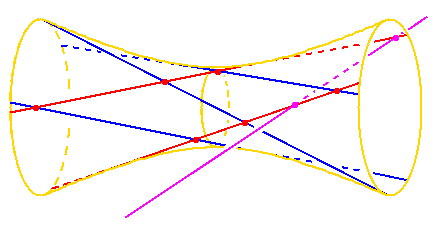Meaning of Picture:
This picture shows that given 4 general lines
(3 blue and one magenta)
in ordinary 3-space,
there will be two red lines meeting all four.
One way to see this is to first consider the
3 blue lines.
If they are mutually skew, they will lie on a
hyperboloid of one sheet.
On the
hyperboloid of one sheet,
there are two families of lines,
and each member of one family meets every member of the other family.
The blue lines are in one family, and the set of
lines which meet all
3 blue lines is the other family
(in red).
If we now consider the fourth
magenta line, it will meet the
hyperboloid in two points, the
magenta dots.
Through each of these magenta dots
there will be a unique line, in the second family.
These two lines are the two lines which meet our
four given lines.
The Reality of this discussion.
The careful reader will note that the
magenta line need not intersect the
hyperboloid in two points---besides the case of
tangency (which gives rise to a solution counted with multiplicity
2)---it could be disjoint from the
hyperboloid.
This shows that the proper setting for this problem is over the complex
numbers, where the magenta line will always
meet the hyperboloid.
This is a manifestation of a general fact: over the complex numbers,
enumerative geometric questions of this sort always have the same number of
solutions.
This picture illustrates a feature of the real numbers, that the number of
solutions to such questions may depend upon subtle properties of the
configurations of the conditions.
It is in general a difficult problem to determine how many real solutions
there are.
An upper bound is given by the number of complex solutions.
One may ask:
When is this upper bound attained by real solutions?
A recent theorem says that this upper bound is
reached on many problems in enumerative geometry that arise from Schubert's
calculus. It is also attained for certain problems of
counting rational curves in a Grassmann variety, and for many problems
involving flags.
Last modified: 1 July 2016
